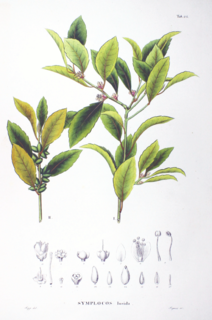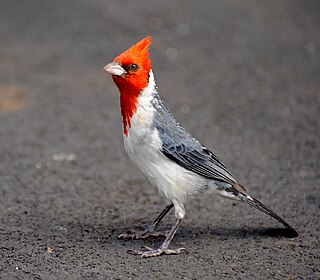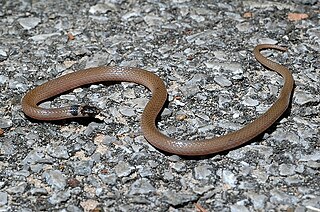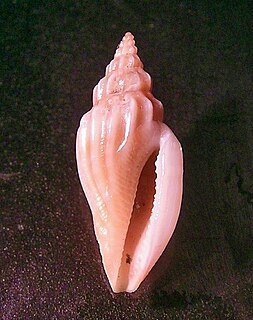
The yellow-rumped warbler is a North American bird species combining four closely related forms: the eastern myrtle warbler ; its western counterpart, Audubon's warbler ; the northwest Mexican black-fronted warbler ; and the Guatemalan Goldman's warbler.

Setophaga is a genus of birds of the New World warbler family Parulidae. It contains at least 33 species. The males in breeding plumage are often highly colorful. The Setophaga warblers are an example of adaptive radiation with the various species using different feeding techniques and often feeding in different parts of the same tree.

Symplocos is a genus of flowering plants in the order Ericales. It contains about 300 species distributed in Asia and the Americas. Many species grow in humid tropical regions. This is sometimes considered to be the only genus in family Symplocaceae. Plants in this family are shrubs and trees with white or yellow flowers.

Puccinia coronata is a plant pathogen and causal agent of oat and barley crown rust. The pathogen occurs worldwide, infecting both wild and cultivated oats. It is a relatively new disease of barley in North America. It was first found in 1992 in a barley breeding nursery near Clay Center, Nebraska. Since then, crown rust has been found throughout the upper Midwest, with greatest incidence in the central Red River Valley of North Dakota and Minnesota. In that region the alternate host, common buckthorn, grows abundantly in shelter belts and riparian areas. Since 1993, outbreaks of crown rust have occurred on barley and forage grasses at several localities in this region. The extent of yield losses in barley caused by this disease have not been determined. Crown rust posed a threat to barley production, because the first infections in barley occur early in the season from local inoculum. Crown rusts have evolved many different physiological races within different species in response to host resistance. Each pathogenic race can attack a specific line of plants within the species typical host. For example, there are over 290 races of P. coronata. Crops with resistant phenotypes are often released, but within a few years virulent races have arisen and P. coronata can infect them.

The wrenthrush or Zeledonia is a unique species of nine-primaried oscine which is endemic to Costa Rica and western Panama. Neither a wren nor a thrush, it has a short tail, rounded wings and elongated tarsi.

The red-crested cardinal is a songbird, the species belonging to the family of the tanagers (Thraupidae). Notwithstanding its similar name, this bird is not closely related to the true cardinal family (Cardinalidae).
Symplocos anamallayana is a species of plant in the family Symplocaceae. It is endemic to India.
Symplocos bractealis is a species of plant in the family Symplocaceae. It is endemic to Sri Lanka.
Symplocos cordifolia is a species of plant in the family Symplocaceae. It is endemic to Sri Lanka.
Symplocos fuscata is a species of plant in the family Symplocaceae. It is endemic to Ecuador. Its natural habitat is subtropical or tropical moist montane forest.
Symplocos octopetala is a species of evergreen woody plant with small white flowers in the family Symplocaceae. It is endemic to Jamaica. First described in 1788, the most recent concept of the species includes three taxa described as separate species in the late 19th and early 20th century.
Symplocos oligandra is a species of plant in the family Symplocaceae. It is endemic to India. It is threatened by habitat loss.
Symplocos peruviana is a species of plant in the family Symplocaceae. It is endemic to Peru.

Symplocaceae is a family of flowering plants in the order Ericales, including two genera, Symplocos and Cordyloblaste, totalling about 260 known species. The common name for Symplocaceae is sweetleaf. Symplocaceae has a transpacific distribution that covers the Southeast United States, South America, Southeast Asia and Northern Australia. Plants in the family Symplocaceae are generally trees or shrubs, and are found in humid, tropical, montane forests within their range.

Anania coronata, the elderberry pearl, elder pearl or crowned phlyctaenia, is a species of moth of the family Crambidae. It was described by Johann Siegfried Hufnagel in 1767 and is found in the northern parts of the Palearctic ecozone. It was previously also listed for the Nearctic ecozone. The species closely resembles Anania stachydalis.

The southeastern crown snake is a common species of small colubrid snake endemic to the southeastern United States.

Doto coronata is a species of small sea slug or nudibranch, a shell-less marine gastropod mollusc in the family Dotidae. It is the type species of the genus Doto.

Symplocos tinctoria is a deciduous or evergreen shrub or tree. It is recognized by pith of twigs chambered; by foliage not notably aromatic when bruised, leaves finely hairy beneath. Shrubs or trees to 17 m tall by 36 cm DBH. The largest first-year twigs are under 3 mm across, terminal buds with acute tip, scales ciliate. Leaves are 7–15 cm long, margin entire or occasionally some teeth on the apical half, with a sweet taste that may be faint in old leaves. It is conspicuous when in flower; flowers opening before new leaves develop, fragrant, in clusters from axils of previous year's leaves or from just above the leaf scars if the leaves have fallen; the petals are creamy yellow to yellow, with one pistil. Fruits nearly cylindrical to ellipsoid drupes 8–12 mm long, with thin pulp and a hard stone containing 1 seed; the tip usually retaining parts of the sepals. Foliage is relished by browsing wildlife. A yellow dye may be obtained from bark and leaves. It flowers Mar to May.

Eucithara is a genus of small to quite large sea snails, marine gastropod mollusks in the family Mangeliidae.











